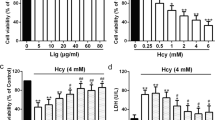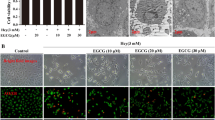Abstract
Purpose
Homocysteine (Hcy) is an independent risk factor for cardiovascular diseases that impairs endothelial function. We investigated whether the impaired endothelial function can be restored by the eNOS transcription enhancer AVE3085 in porcine coronary arteries. The effects of AVE3085 against Hcy on eNOS-NO function were studied and further investigations were conducted to reveal the role of arginase and the signaling pathway of eNOS activation in the effect of AVE3085 on endothelial dysfunction caused by Hcy.
Methods
Myograph study of vasorelaxation, electrochemical measurement of NO, RT-PCR and Western blot analysis of eNOS, iNOS expression, and eNOS phosphorylation were performed. Arginase activity was determined by urea production and O2 .− generation by lucigenin-enhanced chemiluminenscence.
Results
Exposure to Hcy for 24 h attenuated bradykinin-induced relaxation and NO release, downregulated eNOS mRNA expression and protein expressions of eNOS and p-eNOSSer1177 whereas it upregulated iNOS expression. AVE3085 restored NO release and relaxation, enhanced eNOS but decreased iNOS expression. Inhibition of protein kinase Akt or PI3 kinase attenuated the effect of AVE3085 on relaxation and eNOS phosphorylation. Arginase activity and O2 .− production were inhibited by AVE3085 in Hcy-exposed vessels.
Conclusions
AVE3085 prevents Hcy-induced endothelial dysfunction in coronary arteries by preservation of NO production and suppression of O2 .− generation. Preservation of NO is attributed to upregulation of eNOS expression, activation of eNOS via phosphorylation of Ser1177 through a PI3 kinase/Akt-dependent pathway, and inhibition of arginase. Reduction of O2 .− generation results from reversal of eNOS uncoupling and inhibition of arginase and iNOS.






Similar content being viewed by others
References
Hankey GJ, Eikelboom JW. Homocysteine and vascular disease. Lancet. 1999;354:407–13.
Handy DE, Loscalzo J. Homocysteine and atherothrombosis: diagnosis and treatment. Curr Atheroscler Rep. 2003;5:276–83.
Woo KS, Chook P, Lolin YI, et al. Hyperhomocyst(e)inemia is a risk factor for arterial endothelial dysfunction in humans. Circulation. 1997;96:2542–4.
Dimitrova KR, DeGroot KW, Pacquing AM, et al. Estradiol prevents homocysteine-induced endothelial injury in male rats. Cardiovasc Res. 2002;53:589–96.
Tasatargil A, Dalaklioglu S, Sadan G. Poly(ADP-ribose) polymerase inhibition prevents homocysteine-induced endothelial dysfunction in the isolated rat aorta. Pharmacology. 2004;72:99–105.
Chen C, Conklin BS, Ren Z, Zhong DS. Homocysteine decreases endothelium-dependent vasorelaxation in porcine arteries. J Surg Res. 2002;102:22–30.
Zhou W, Chai H, Lin PH, Lumsden AB, Yao Q, Chen C. Ginsenoside Rb1 blocks homocysteine-induced endothelial dysfunction in porcine coronary arteries. J Vasc Surg. 2005;41:861–8.
Fu W, Conklin BS, Lin PH, Lumsden AB, Yao Q, Chen C. Red wine prevents homocysteine-induced endothelial dysfunction in porcine coronary arteries. J Surg Res. 2003;115:82–91.
Spencer TA, Chai H, Fu W, et al. Estrogen blocks homocysteine-induced endothelial dysfunction in porcine coronary arteries(1,2). J Surg Res. 2004;118:83–90.
Duan J, Dai S, Fang CX, et al. Phytoestrogen alpha-zearalanol antagonizes homocysteine-induced imbalance of nitric oxide/endothelin-1 and apoptosis in human umbilical vein endothelial cells. Cell Biochem Biophys. 2006;45:137–45.
Nagareddy PR, Xia Z, McNeill JH, MacLeod KM. Increased expression of iNOS is associated with endothelial dysfunction and impaired pressor responsiveness in streptozotocin-induced diabetes. Am J Physiol Heart Circ Physiol. 2005;289:H2144–52.
Santhanam L, Lim HK, Lim HK, et al. Inducible NO synthase dependent S-nitrosylation and activation of arginase1 contribute to age-related endothelial dysfunction. Circ Res. 2007;101:692–702.
Kim JH, Bugaj LJ, Oh YJ, et al. Arginase inhibition restores NOS coupling and reverses endothelial dysfunction and vascular stiffness in old rats. J Appl Physiol. 2009;107:1249–57.
Sasaki K, Heeschen C, Aicher A, et al. Ex vivo pretreatment of bone marrow mononuclear cells with endothelial NO synthase enhancer AVE9488 enhances their functional activity for cell therapy. Proc Natl Acad Sci USA. 2006;103:14537–41.
Wohlfart P, Xu H, Endlich A, et al. Antiatherosclerotic effects of small-molecular-weight compounds enhancing endothelial nitric-oxide synthase (eNOS) expression and preventing eNOS uncoupling. J Pharmacol Exp Ther. 2008;325:370–9.
Riad A, Westermann D, Van Linthout S, et al. Enhancement of endothelial nitric oxide synthase production reverses vascular dysfunction and inflammation in the hindlimbs of a rat model of diabetes. Diabetologia. 2008;51:2325–32.
Fraccarollo D, Widder JD, Galuppo P, et al. Improvement in left ventricular remodeling by the endothelial nitric oxide synthase enhancer AVE9488 after experimental myocardial infarction. Circulation. 2008;118:818–27.
Yang Q, Xue HM, Wong WT, et al. AVE3085, an enhancer of endothelial nitric oxide synthase, restores endothelial function and reduces blood pressure in spontaneously hypertensive rats. Br J Pharmacol. 2011;163:1078–85.
Xue HM, He GW, Huang JH, Yang Q. New strategy of endothelial protection in cardiac surgery: Use of enhancer of endothelial nitric oxide synthase. World J Surg. 2010;34:1461–9.
Xue HM, Yu CM, Underwood MJ, Huang JH, Yang Q. AVE3085 protects coronary endothelium from the impairment of asymmetric dimethylarginine by activation and recoupling of eNOS. Cardiovasc Drugs Ther. 2012;26:383–92.
Yang Q, Ge ZD, Yang CQ, Huang Y, He GW. Bioassay of endothelium-derived hyperpolarizing factor with abolishment of nitric oxide and the role of gap junctions in the porcine coronary circulation. Drug Dev Res. 2003;58:99–110.
Yang Q, Zhang RZ, Yim AP, He GW. Release of nitric oxide and endothelium-derived hyperpolarizing factor (EDHF) in porcine coronary arteries exposed to hyperkalemia: effect of nicorandil. Ann Thorac Surg. 2005;79:2065–71.
Ge ZD, Zhang XH, Fung PC, He GW. Endothelium-dependent hyperpolarization and relaxation resistance to N(G)-nitro-L-arginine and indomethacin in coronary circulation. Cardiovasc Res. 2000;46:547–56.
Huang JH, He GW, Xue HM, et al. TRPC3 channel contributes to nitric oxide release: significance during normoxia and hypoxia-reoxygenation. Cardiovasc Res. 2011;91:472–82.
Skatchkov MP, Sperling D, Hink U, et al. Validation of lucigenin as a chemiluminescent probe to monitor vascular superoxide as well as basal vascular nitric oxide production. Biochem Biophys Res Commun. 1999;254:319–24.
Corraliza IM, Campo ML, Soler G, Modolell M. Determination of arginase activity in macrophages: a micromethod. J Immunol Methods. 1994;174:231–5.
Ramaswami G, Chai H, Yao Q, Lin PH, Lumsden AB, Chen C. Curcumin blocks homocysteine-induced endothelial dysfunction in porcine coronary arteries. J Vasc Surg. 2004;40:1216–22.
Zhang X, Li H, Jin H, Ebin Z, Brodsky S, Goligorsky MS. Effects of homocysteine on endothelial nitric oxide production. Am J Physiol Renal Physiol. 2000;279:F671–8.
Lang D, Kredan MB, Moat SJ, et al. Homocysteine-induced inhibition of endothelium-dependent relaxation in rabbit aorta: role for superoxide anions. Arterioscler Thromb Vasc Biol. 2000;20:422–7.
Topal G, Brunet A, Millanvoye E, et al. Homocysteine induces oxidative stress by uncoupling of NO synthase activity through reduction of tetrahydrobiopterin. Free Radic Biol Med. 2004;36:1532–41.
Acknowledgments
This work was supported by Hong Kong GRF grants CUHK4789/09M & 4774/12M, National Natural Science Foundation of China 81200123, CUHK Direct Grant 4054015, Tianjin Municipal Science & Technology Commission (10JCYBJC26400), and Key Medical Program of Tianjin Binhai New Area Health Bureau (2011BHKZ001 & 2012BWKZ008) and Tianjin Health Bureau (2012KZ009).
The authors gratefully acknowledge the generous provision of AVE3085 by Sanofi-Aventis Deutschland GmbH, Frankfurt, Germany.
Conflict of Interest
None.
Author information
Authors and Affiliations
Corresponding author
Additional information
Qin Yang and Hong-Mei Xue contribute equally.
Electronic supplementary material
Below is the link to the electronic supplementary material.
ESM 1
(DOC 57 kb)
Rights and permissions
About this article
Cite this article
Yang, Q., Xue, HM., Underwood, M.J. et al. Mechanistic Studies of AVE3085 Against Homocysteine in Endothelial Protection. Cardiovasc Drugs Ther 27, 511–520 (2013). https://doi.org/10.1007/s10557-013-6478-5
Published:
Issue Date:
DOI: https://doi.org/10.1007/s10557-013-6478-5




